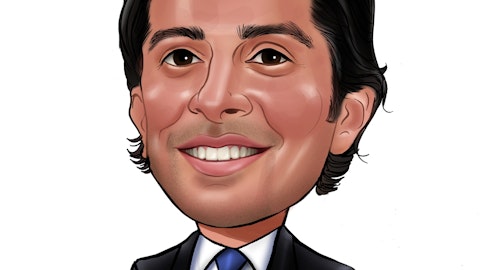And in general, lowering the cost of a DRS system, because they are expensive, is wonderful. We can also democratize it in so far, as in a lot of places, it’s not just the cost, it’s also – they don’t have 60,000 square foot supermarkets that could have one of these really expensive RVMs, reverse vending machines. People want to use their cell phone wherever they go on the country side, right. So, that’s where we come. And just like we offer a differentiated offering with Digimarc Validate for any product authentication, we can do the same thing, which is a key component of the DRS. And there is not an area that we want to get into directly ourselves. This is an area we will go through our partners, but a really exciting opportunity.
We can’t wait to see the final text of the PPWR and move forward from there based on all the marching orders. And again, the key thing about the PPWR, right, is the R stands for regulation, which means it’s not negotiable. The member states are going to have to adopt whatever is in this final text.
Jeff Bernstein: Got it. Okay. And then anything on your partners initial win and how that’s progressing and kind of any learnings from that?
Riley McCormack: Yes, progressing well. I don’t really know if there is any learnings yet today, but we will – just like with our biggest commercial customer, the best way to earn the trust every day is to not talk about our customers’ business on their behalf. But obviously, because this is a national scheme, I would assume it would become very public whenever the country is ready to talk about it, just rolling out I am sure. Once we are allowed to amplify it, trust me, Jeff, we will.
Jeff Bernstein: Yes, understand. Okay. And then just I wanted to make sure I understood on automate. Does automate imply that there is some factory automation element to how something’s being used, or is that not the right way to automatically think about it?
Riley McCormack: No, that’s right. It’s in fulfillment centers, distribution centers. It’s a way to apply digital watermarks in the Illuminate platform in the process of some sort of automation, right. So, multiple use cases – sorry, multiple locations, right, distribution centers, performance centers, where this could be applied, where there is currently automation today. And either, one, there actually is an automation that’s still being done by humans because of the other means identification don’t work at all or there is some automation that doesn’t work well or it’s really expensive because others means of identifications don’t work well. And that’s the opportunity. If you see in our deck, we will officially launch automate in the not-too-distant future.
Incredible, we haven’t even launched this product yet, and we have multiple customers not just historic, but if you paid attention to the prepared remarks, there was multiple deals in Q1 just from automate. That is an example of having wonderful partners in this space as well as just a real demand for a high ROI return, which is either we are actually allowing the initial steps of automation that were not existing before. We are also taking an automation though it’s kind of kluge here, didn’t work well, and bringing it in the 21st century.
Jeff Bernstein: Terrific. And then last question. In terms of that newest ability, because I think you only started talking about it pretty recently, of tracking consumer interactions, both in the e-commerce world and then in the physical world, it sounds like you already are signing some deals relating to that?
Riley McCormack: On the digital side?
Jeff Bernstein: Yes. Or on a hybrid of – we are going to follow both the e-commerce and physical world, yes?
Riley McCormack: No. So, nothing yet signed. We announced this not too long ago. It takes a while for pipeline. But it’s an area of interest, not just directly with some existing customers, but really from our partners because this is something that they wrestle with, our partners, right, is they are getting asked to do some really difficult things. There is a very big partner of ours that’s talking about how they are trying to help customers in the multimedia world, right. And they can offer stuff like content repositories or creating artwork, not just for physical packages, but for e-commerce, right. That’s all really, really important, really, really interesting. The more opportunities we can offer in this hybrid world through our partners, it just makes their conversations easier.
It gives them a reason to ping their existing customers. They had no way to talk in a while. We have this great new partnership that’s coming called Digimarc, I will tell you more. So, I would assume here it’s going to be partner-led only because our partners get this. And you have a conversation. This is back to the operating leverage our CoEs will give us. You have a conversation with a partner and that partner has got 1,000 salespeople, you can have 1,000 customers or 1,000 conversations with customers through that entity as opposed to us going back during QBR is with our existing customers say, hey, let’s say there is a new functionality. So, I would assume this one in particular. And as we have been talking about a lot of our business, customer led.
But just like I think Jeff is asking about the apply-now activate-later the next-gen digital watermark, the CoEs get it. And they get it immediately and there is a lot of excitement.
Jeff Bernstein: Okay. And just to understand from kind of a real-world example. So, you could have a packaging bar who has been discussing Digimarc watermarked packaging and the interaction that that allows with people who then is going back to say, oh, and by the way, the Digimarc’s ability to track all of this in a cloud-based database means that we can now also intercept when somebody has interacted online relative to some offer that you made or relative to something on social media, etcetera, etcetera. And we can wrap that into a complete view of how the person interacted, not just with the package, but with your other advertising or promotional messages.
Riley McCormack: Kind of, but really, so two things, right. The two partners that most get this are the pre-media/printing partners, right. And this is where customers are coming to them and saying, hey, how do we apply with Sunrise 2027, you are the packaging expert or hey, we want to put a QR code on our packaging for consumer engagement, right. Up until now, they are like, right, we can put a QR code on and do this stuff. They didn’t have the technical back-end or the expertise or the technology to say, I am so glad you asked us about that. Let’s talk about how we are going to apply this, not just to your physical packaging, but also for all your owned multimedia. Let’s have a broader conversation where we are not just talking about packaging, which tends to be a competitive industry, right, on fair purpose.
Let us talk about this whole thing we can offer even in the digital domain. And that makes their end customers a lot stickier because now they are not just coming to procure articles in a packing, they are coming to them to solve a bigger – to get what they wanted to do with QR codes, whether it is a direct consumer channel, but across both the packaging but also the internet. The other big area of partners are the advertising agencies, right. So, these advertising agencies are in charge of coming up with campaigns and one of the things we can offer is not just stickier customers or a chance to reach out, they also can monetize and build a campaign. We don’t want to be in the content creation business of putting together this – I mean some of these campaigns are seven figures because they are incredibly complex and beautiful and detailed, and you have seen the quality of ads, like its super pulse, right.
That’s not an area that we want to get into. But now they, as an advertising agency, can say, hey, I know we have been talking about a certain campaign. Can you imagine if we not – if we brought your physical products and not just the internet into this or vice versa, if we actually could bring in the internet to your physical – what you plan to do in the physical world, maybe it’s bus stops, maybe it’s on a store – point of sales in the store. And not only can you follow the consumer and tell them, as you – as we are rolling out this campaign, you can hit them in both the physical and digital domain. You can also get the data back. And that is the most powerful point is that, the old adage in advertising is that half your advertising dollars are wasted, you just don’t know which half.
What people advertise because they want to get consumers to buy things, that is the reason advertising exists. And now you can actually run campaigns, whether they are email campaigns or internet campaigns and say, yes, it wasn’t just engagement or open rakes. I know which one of these campaigns led to somebody interacting with the physical product within, pick-your-favorite time, 48 hours. It’s a holy grail. And it can – the same way that advertising became so much more effective with the advent of online, the next wave is, okay, now that you have online, how do you tie online activity to physical behavior, that’s the holy grail. Advertising spends about to get an impression…
Jeff Bernstein: Okay. Thanks for taking my questions.
Riley McCormack: Thanks Jeff.
Operator: There are no further questions at this time. I would now like to turn the floor back over to Riley McCormack for closing comments.
Riley McCormack: Well, thank you everybody for joining us today. That’s all we have. Have a wonderful rest of your day.
Operator: This concludes today’s teleconference. You may disconnect your lines at this time. Thank you for your participation.
Follow Digimarc Corp (NASDAQ:DMRC)
Follow Digimarc Corp (NASDAQ:DMRC)
Receive real-time insider trading and news alerts


